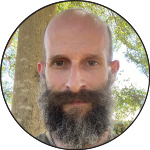
Am Fam Physician. 2022;106(6):711
Author disclosure: No relevant financial relationships.

9:00 a.m.
My first patient is a 16-year-old girl with a massive skin lesion down the right side of her body that has been there since birth. This week the plaques started to cause pain and felt warm in one location. Suspecting a superinfection, I start her on antibiotics and hydrocortisone cream. I send my dermatologist friend in the United States pictures of the plaques, and she diagnoses epidermal nevus syndrome.
9:30 a.m.
I see a six-month-old experiencing fevers, diarrhea, and vomiting. The malaria thick smear test is positive for Plasmodium falciparum malaria at eight to 10 parasites per high-power field. The patient has a sunken anterior fontanelle and dry mucous membranes. I treat him with zinc, oral rehydration solution, and artemether/lumefantrine (Coartem).
10:00 a.m.
A father brings in his three-year-old daughter who has been having difficulty breathing, a cough, and a fever for four days. Her temperature is 102.9°F (39.4°C), respiratory rate of 50, SpO2 of 91%, and mild chest wall retractions. A malaria test result is negative. We immediately start amoxicillin to empirically treat for pneumonia because the closest radiography machine is more than two hours away, and the local mortality rates for patients younger than five years are very high.
11:00 a.m.
My next patient is a 23-year-old man leaning backward as he walks with swelling in his ankles. He reports low back pain and has pitting edema of his ankles and a classic gibbus deformity (i.e., angulated spine due to collapse of several vertebral bodies from tuberculosis infection in the spine). I immediately initiate antituberculosis medications.
8:30 p.m.
The clinician on call telephones to ask if I could help transport a patient with a gunshot wound to the hospital. We find the patient in the darkness on a dirt path. People shooting each other over cows and the lack of medical care available in the local government hospitals are equally discouraging.

7:30 a.m.
I start the day at a local food pantry, seeing patients who are homeless as part of our mobile outreach services. I clip thick toenails on my first patient whose nail clippers “aren’t strong enough to cut through them, doc.”
9:00 a.m.
I help a man restart medications for heart disease. His blood pressure is sky-high. It was difficult to manage his meds when he lived in a tent, but he has recently moved into a shelter and is determined to get healthy.
12:00 p.m.
I drop off wound supplies to a patient at a seasonal shelter. Through a grant, we put together wound care bags with one week’s worth of supplies. This patient has open wounds on his feet from frostbite after returning to the shelter too late for entry. Had we known, we could have given him one of our free sleeping bags and tents.
2:00 p.m.
The many no-shows in my office this afternoon remind me that our mobile outreach is much more effective. I see a Spanish-speaking patient with an interpreter; she is very excited as she recently got housing and can finally get away from her abusive partner. She is ready to reduce her alcohol use. She declines inpatient detox because she fears losing her new apartment. We start naltrexone (Revia). This is a great example of “housing first” being successful.
3:15 p.m.
I receive a text from a recovery coach seeing a patient during house calls. The patient is reducing their dependence on synthetic cannabinoids (K2) and crack cocaine by taking baclofen (Lioresal). The patient apologizes for missing their appointment with me this week.
6:00 p.m.
I talk with my wife on the drive home. She is an obstetrician and on call. We agree we helped some people today, but some things slipped between our fingers. We offer each other words of support.
